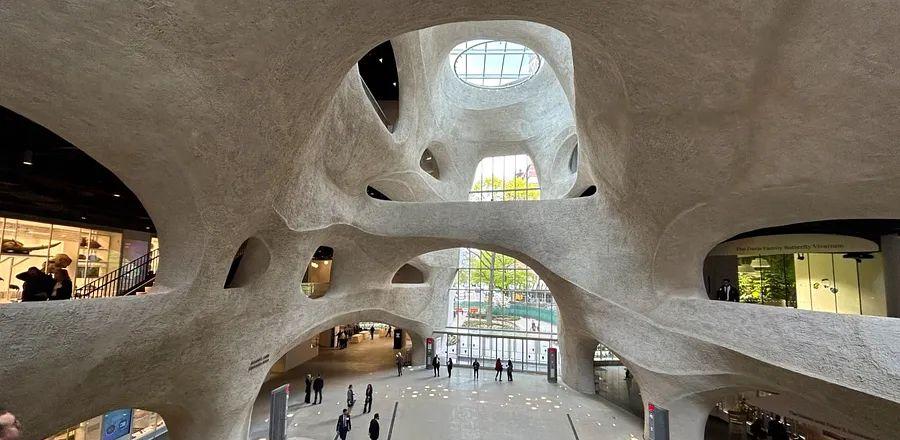An Exclusive Preview of the American Museum of Natural History’s New Wing

After years of development, the latest addition to New York City’s American Museum of Natural History opened its doors on Thursday, May 4. This remarkable wing not only creates a striking new entrance on 79th Street and Columbus Avenue but also features the Richard Gilder Center for Science, Education, and Innovation, which includes several captivating new exhibits, notably the museum’s first permanent insect display in half a century.
An Aesthetically Functional Structure
Guests access the new wing through the canyon-like Kenneth C. Griffin Exploration Atrium, a five-story space designed by Studio Gang to resemble a massive block of concrete that has been artistically eroded. (This architecture firm, led by Jeanne Gang, is also recognized for Chicago’s Vista Tower—the third tallest building in the city—and the forthcoming St. Regis Chicago, along with the new Arkansas Museum of Fine Arts in Little Rock.)
“In the design [process], we sought spaces that would inspire exploration,” Gang shared during a recent media preview. “This exploration led us to examine geological landscapes, showcasing how natural forces shape materials.”
To create these organic forms, Gang’s team utilized a material known as shotcrete, which involves spraying concrete directly onto rebar and is primarily used in infrastructure projects such as tunnels and subways.
Here, the design prioritizes functionality. The museum's 150-year evolution led to numerous dead ends, confusing pathways, and exhibits that lacked natural light.
“We really envisioned the building as a way to enhance the visitor experience and improve circulation throughout the entire museum,” Gang noted, emphasizing that the building's bridges and curves were crafted to guide guests seamlessly into adjacent spaces. Large windows and various skylights fill the museum with natural light, fostering a “visceral connection to the outdoors,” as Gang described it.

Image by Iwan Baan
“This building creates new connections to existing structures in over 30 locations,” Gang stated. “Visitors can now navigate loops between the halls, enjoying the museum’s delightful continuities and contrasts without encountering those frustrating dead ends.”
Before guests venture to the Hall of Gems, seek out the giant blue whale or follow the new paths leading to the Rose Center for Earth and Space; there are plenty of reasons to linger in the Gilder Center beyond its atrium.
Live insects—including butterflies—on display
On the ground floor to the left of the entrance, the 5,000-square-foot Susan and Peter J. Solomon Family Insectarium allows visitors to engage closely with live insects often misunderstood, helping them appreciate the vital roles these creatures play in ecosystems and food sources. The Insectarium features a colony of leafcutter ants (safely behind glass), an 8,000-pound resin beehive model, pinned specimens, and interactive digital displays.

Photo by Chris Ford/Flickr
One floor above, the 2,500-square-foot Davis Family Butterfly Vivarium invites visitors to stroll among approximately 80 species of free-flying butterflies while discovering their vital role as environmental indicators. There’s also a pupae incubator that displays the butterfly life cycle in real time—if you're fortunate, you might witness a swallowtail or blue morpho butterfly emerge from its chrysalis. While entry to the Insectarium is included with general admission, guests need to buy a timed ticket for the Vivarium at an additional cost.

Photo by Lyndsey Matthews
Engaging digital experiences and more
An engaging ticketed attraction on the third floor known as Invisible Worlds serves as the “icing on the cake” of the Gilder Center, according to Ellen Futter, the former president of the American Museum of Natural History.
In this 12-minute looping 360-degree experience, Futter, who has recently concluded her 30-year tenure now that the building is finished, stated, “Visitors will delve into the hidden realms of the natural world. They will see, feel, and hear the very essence of life across various forms and ecosystems, including within the human body and brain, helping them to understand the fundamental truth that all life is interconnected.”

Photo by Iwan Baan
Beyond the new permanent exhibition areas, the Gilder Center also houses the David S. and Ruth L. Gottesman Research Library and Learning Center, featuring a public reading room, as well as the Learning Labs, which are advanced educational spaces for students utilizing technology like a 22-foot-long panoramic projection system and 3D printers as part of their learning experience.
Visiting Information
The Gilder Center welcomes visitors daily from 10 a.m. to 5:30 p.m. Access is available through its main entrance on Columbus Avenue at 79th Street or via any entrance to the American Museum of Natural History. Admission to the Gilder Center is included with the standard museum ticket price of $28 for adults and $16 for children; tickets can be purchased in advance at tickets.amnh.org. (Residents of New York, New Jersey, and Connecticut can enter based on a pay-what-you-wish model.) Timed tickets for the Invisible Worlds exhibit and the Davis Family Butterfly Vivarium must be bought separately from general admission.
Evaluation :
5/5



